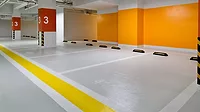New Water-Based Alkyd Dispersion Technology
Protecting Wood Decks and Garden Furniture
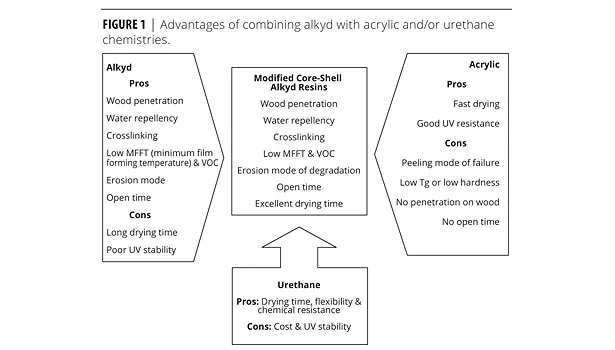
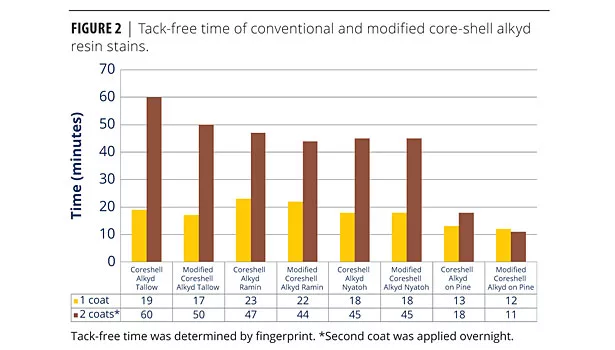

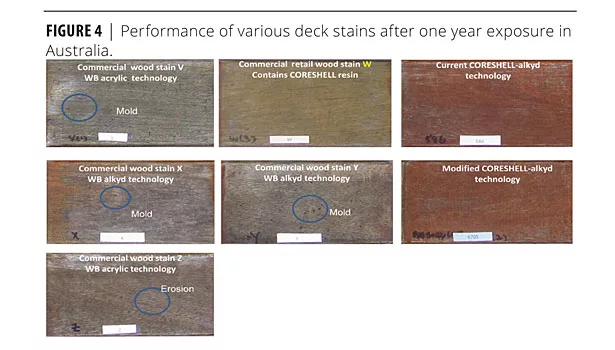
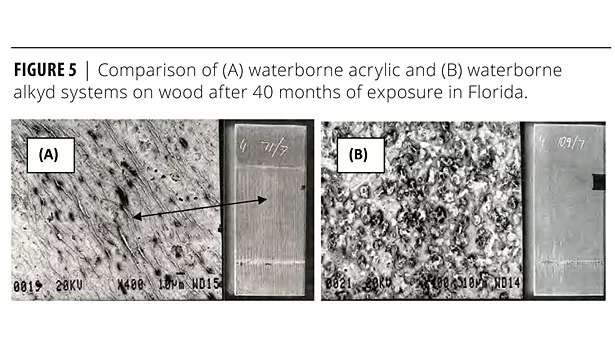
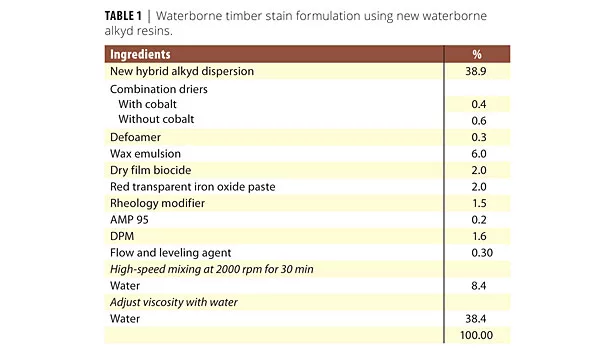

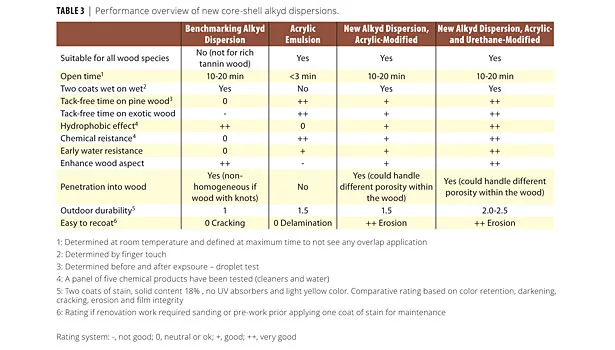
During its lifetime, a deck is exposed to a multitude of influences that can lead to damage. Ultraviolet (UV) radiation, acid rain, dirt, chemical spills, scratches and foot traffic can all affect the appearance of wood by:
• Changing its color (to grey or washed out due to loss of tannins);
• Increasing its sensitivity to mildew, fungi, insects, etc.;
• Increasing its water sensitivity;
• Causing cracking or delamination; and
• Increasing dirt pick-up.
After months of outdoor exposure without protection, the wood will fade and begin to lose its initial color and, with time, can show some cracking and could be attacked by insects or fungi. Heavy rainfall and strong sunlight are of particular concern in tropical countries. To avoid this type of damage and prevent the need for costly and complex renovation involving removal of the surface oxidation layer, regular maintenance of the wood substrate is necessary.
Specifically, the use of a deck stain will help to slow down these destructive processes by developing a very thin film that protects the wood and restores its original color. Finding a deck stain that can equally protect different wood species is a challenge, because different types of wood have different tannin concentrations, densities and durabilities. Furthermore, wood is considered to be a “live substrate” because its dimensions change in response to changes in temperature and humidity, and the amount of shrinkage or expansion also depends on the species.
One common approach to maintaining decking is the use of “teak oil,” a solution of natural oils mixed with additives (fungicides, biocides, etc.) and diluted with a significant amount of solvent such as white spirit, which is a VOC that contributes to CO2 emissions. While these conventional oils penetrate the wood, they do not seal it with a protective film. Because the natural oils in teak oil are not polymeric, they degrade relatively quickly upon exposure to UV radiation. Thus, this solution primarily provides an aesthetic effect but does not afford much wood protection. In fact, in climates with high UV exposure rates, two applications of teak oil per year are generally recommended in order to retain good color, particularly for horizontal surfaces.
A protective coating saturates the pockets and cells inside the wood with an oil-based product to generate a hydrophobic effect (water repellency) that will prevent water from attacking any lignin (the main component in wood) that might have been degraded into water-soluble components due to UV radiation exposure. Ideally a protective coating should saturate the wood. Two coats of a low-solid-content stain are required to saturate the wood. Traditional coatings have been solvent-based.
Next-Generation Waterborne Binder Dispersions
In response to the need to reduce VOCs, coatings formulators have introduced water-based systems. These coatings, however, generally have exhibited limited durability and have been unsuitable for rich-tannin woods. Commonly these waterborne stains have been created by modifying acrylic latex formulations initially developed for vertical surfaces. While they leave a film on the surface that protects the wood, they do not penetrate the surface like oils or sealers and thus do not adhere well. To overcome this issue, special adhesion mechanisms have been developed, but because the latex film is not integrated into the wood structure, cracking, flaking and peeling of the coating are often observed.
Next-generation waterborne binder dispersions from Cytec have been tailor made for application on wood decking and furniture that are both durable and easy to use, reducing the frequency of required maintenance. Furthermore, these new resins balance the need for film longevity with failure mode, exhibiting a positive mode of erosion that indicates when an application of one new coat is necessary, rather than cracking and peeling, which is often the case with current systems that require the deck be stripped and recoated with multiple coats.
The new waterborne alkyd dispersions contain the natural oils necessary for penetrating and feeding the wood substrate as well as acrylic and/or urethane polymer backbones that provide a range of features essential for the protection of the deck or furniture. Figure 1 shows the advantage of combining alkyd with acrylic and/or urethane chemistries.
Due to their very low particle size (90 nm), the new modified core-shell alkyd resins easily penetrate into the wood fiber. The polymers then cure oxidatively within the wood matrix, making it an integral part of the wood structure. This film formation helps to overcome and reinforce the dimensionally unstable nature of the wood.
With these attributes, the new waterborne alkyd dispersions prepared from hybrid alkyd acrylic and/or urethane-modified resin systems allow formulators and applicators to develop and apply new deck stain products that:
• Are applicable on all types of wood with a uniform aspect, including those with high porosity;
• Are highly durable, lasting nearly twice the customary time frame (depending on formulation), with slow erosion instead of damaging peeling, which allows easy renovation when needed without the need to sand or strip all previous stain;
• Can be developed in different colors to match the original shade of the wood;
• Can be applied quickly, allowing the possibility to coat a full deck within a weekend or even a day depending on its size, but also with an open time good enough to achieve a nice look without overlap marks;
• Have VOC content as low as < 50 g/L (compared to > 400g/L for teak oil);
• Are easy to clean up with water and soap, with no need for solvent, reducing VOC emissions and extending the life of tools; and
• Penetrate up to 100 µm into the wood to feed and bond with it.
Experimental
To demonstrate the performance of these new alkyd dispersions, representative waterborne stains containing different alkyd dispersions were prepared and evaluated. Table 1 shows the basic formula that was used. A different alkyd dispersion was substituted for each study. For all evaluations, it was decided to use a simple formula in order to better visualize the benefit of the new binders. The system included a drier package, a defoamer, a flow and leveling agent and a thickener for preventing the settling of the red iron oxide pigment used. For the outdoor tests, we also included a blend of wax emulsions as typically done by paint suppliers, but no UV absorbers/stabilizers were used so that the durability of the binders could be clearly evaluated. Therefore, the durability of the test formula could be enhanced by choosing the right package of UV absorbers.
Properties such as tack-free time, residual tack, water spot resistance, drying time and open time were evaluated. Durability tests were also conducted both in the lab using a Xenon Weather-o-Meter and at four different outdoor locations around the world comparing the sample formulas to commercially available wood stains.
In a study of tack-free time, it was found that stains based on the new modified core-shell alkyd dispersions have reduced tack-free times compared to conventional core-shell alkyds on a variety of woods including tallow, ramin, nyatoh and pine, which are very rich in tannins (Figure 2). This result indicates that the newly developed products exhibit a unique balance between drying time and open time. Notably, they are able to improve dry time yet maintain a reasonable open time to allow for quick and easy application without the need to worry about overlap marks. Furthermore, the new modified core-shell alkyd resins also led to almost no residual tackiness and better water resistance than conventional core-shell alkyd systems eight hours after application of the second coat.
The affect of co-solvent addition on drying time was also evaluated. It was found that the type and quantity of co-solvent used in the formulation has an impact on the applicability of the system and can also improve the penetration of the coating into the wood, thus reducing the drying time of the second coat (Figure 3).
Extensive durability tests showed that the new modified core-shell alkyd resins provide stain formulations that perform well under a variety of conditions. In the lab, samples were run using ASTM G155 exposure conditions and 0.35W/m2 irradiation, a black panel temperature of 63 +3 °C with a water spray cycle for 1000 h or until failure. Film integrity and color retention were determined visually, while water resistance was measured.
The benchmark alkyd dispersion resin showed a strong dark discoloration while presenting a strong deficiency in film integrity, leading to some micro cracking and wood grain attack, which was visualized by clear water sensitivity when a drop of water was applied for 1 h. After exposure with one coat, all stain was gone, while with two coats the remaining film didn’t present any hydrophobicity at all.
The new resins experienced a very light discoloration but more importantly, the film integrity was perfect, including retention of water repellency. Furthermore, even at 50% longer exposure times, the stain based on the new resin provided good results.
In addition, stain formulations based on the new generation of modified core-shell alkyd dispersions were exposed to a range of natural weathering conditions (Table 2). The new systems did show a uniform excellent level of resistance in all climates and all type of diverse woods, exceeding the durability of previous alkyd dispersion benchmarking by 50% to 100%, depending on which modification they were made of.
Furthermore, panels of different types of exotic woods coated with two coats of a light color system that did not contain any UV absorbers, when exposed for one year in Allunga, Australia, showed strong improvement in terms of durability (Figure 4). Performance in terms of both color retention and erosion were enhanced compared to current alkyd dispersion systems and commercial waterborne deck stains.
Panels coated with the next-generation resin showed excellent homogeneous color shade with very limited color erosion and no peeling despite the fact that no UV protection was incorporated into the formulations. These very good results were also observed at the other global locations.
Results of panels exposed in Florida in the Southern United States can be seen in Figure 5. The panel coated with the acrylic stain clearly shows cracking and peeling (A), while the panel with the stain based on an alkyd dispersion shows only modest erosion of color with no damage to the wood structure.
Conclusion
Next-generation core-shell alkyd resin technology with acrylic and/or urethane modifications has been shown to provide a strong step forward in the performance of waterborne stains for all types of wood used within the decking industry.
Stains containing these new resins offer better drying times with excellent open times, water resistance and extended durability compared to the previous generation of alkyd dispersions (Table 3). They also outperform acrylic resins because they undergo erosion rather than delamination, which allows for easy maintenance. Furthermore, by using formulations based on these new resins, the need for repainting can be delayed due to their improved durability (generally increased by about two times).
Finally, the new systems can be formulated with VOC content levels of < 50 g/L and also require lower quantities of driers than typically used with alkyd resins and can even be formulated with Co-free-driers as needed.
For more information, visit www.cytec.com.
Looking for a reprint of this article?
From high-res PDFs to custom plaques, order your copy today!




